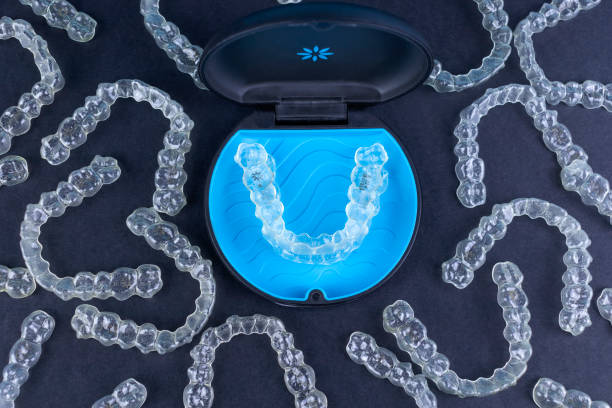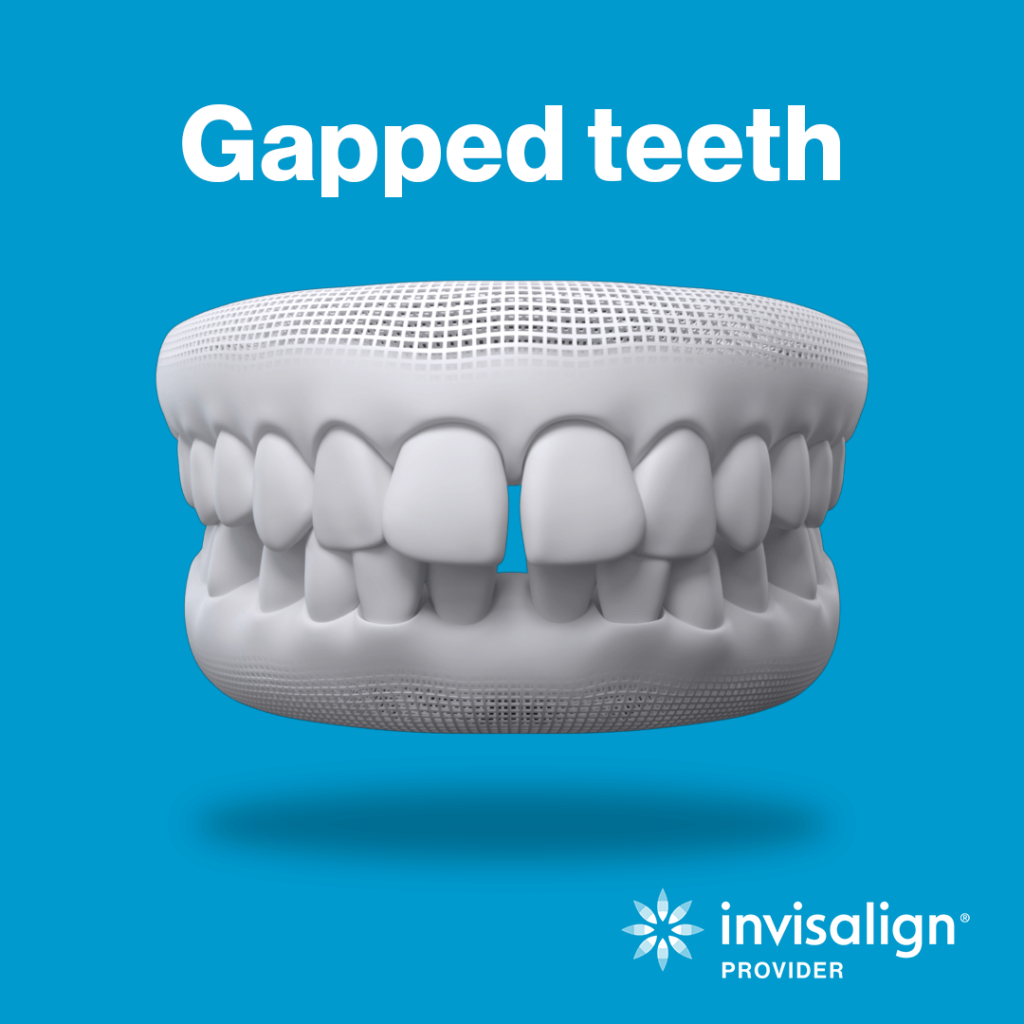“Can Invisalign close a tooth gap?” This is a question that often arises among individuals seeking a solution for their smile concerns. Gaps between teeth, whether small or more noticeable, can affect one’s self-esteem and may lead to dental issues like periodontal disease and overcrowding.
In this article, we will embark on a journey to explore the capabilities of Invisalign, an alternative to braces and a revolutionary orthodontic treatment known for its effectiveness in addressing various dental problems. We’ll uncover how Invisalign can be a game-changer for those seeking to bid farewell to tooth gaps, regain their confidence, and achieve a more harmonious smile. So, if you’ve ever wondered if Invisalign is the right choice to close that gap in your teeth, read on to discover its possibilities and how it might be the key to your dream smile.

Individuals with misaligned teeth generally have two options to consider to achieve straighter teeth: traditional metal braces or Invisalign. Braces comprise of metal brackets and wires that gradually shift teeth over two to three years.
Invisalign, on the other hand, offers a distinct but similar approach. It corrects misaligned teeth by employing clear plastic aligner trays that can be removed when eating, takes a shorter amount of time, and is a discreet treatment that doesn’t impact a patient’s appearance.
When you embark on your Invisalign journey, your dentist or orthodontist will formulate a personalized treatment plan. During periodic check-ups, you will be provided with a fresh set of aligners, each contributing to the gradual adjustment of your teeth. These check-ups typically occur every few weeks.
Depending on the severity of the gap, a small gap can be treated as short as 6 to 9 months, or for more severe gaps, it may take 18 to 24 months to complete.

Tooth gaps, medically known as diastema, refer to spaces or gaps between two or more teeth in the dental arch. These gaps can occur anywhere in the mouth, but they are most commonly observed between the upper front teeth. Tooth gaps can vary in size, from small spaces that are barely noticeable to larger gaps that are more prominent. Several factors, including genetics, tooth size and shape, jaw size, and oral habits can influence the presence of tooth gaps. While some people embrace their tooth gaps as part of their unique smile, others may seek dental treatment to close these gaps for cosmetic or functional reasons. Dental professionals can offer various treatment methods, such as braces, dental bonding, or veneers, to address tooth gaps and create a more harmonious smile.
A gap between teeth, also known as diastema, can be influenced by various factors. It’s essential to consult with a dentist or orthodontist to determine the specific cause of your gapped tooth and explore suitable treatment options if you wish to address the gap for cosmetic or functional reasons. Here are some common reasons why you may have a gapped tooth:
Invisalign is an effective solution for closing spaces between teeth. The process typically begins with a comprehensive examination by a dentist or orthodontist to assess the size of the teeth gap and the overall oral health. A custom treatment plan is then created, tailored to the patient’s needs.
Invisalign treatment involves a series of clear, custom-made aligners that are nearly invisible when worn. These aligners are designed to exert controlled pressure on the teeth, gently shifting them into the correct position over time. For closing tooth gaps, Invisalign aligners focus on moving the adjacent teeth toward each other, effectively closing the gap.
One of the significant advantages of Invisalign is its discreet appearance, making it an appealing choice for individuals who want to address tooth gaps without the noticeable appearance of traditional braces. Regular check-up appointments with the dentist ensure the orthodontic care is progressing as planned, addressing any potential issues early, and adjustments may be made to achieve the desired outcome. Upon completion of the treatment, a custom retainer is often provided to maintain the new tooth alignment and prevent the gap from reappearing. Invisalign offers a comfortable and convenient way to close tooth gaps, although the treatment’s success depends on the gap’s size and the patient’s overall dental alignment.
Gaps between teeth can be caused by various factors such as genetics, dental hygiene practices, or previous injuries. If you’re wondering if Invisalign can be an effective solution for closing these gaps, it’s important to consider the specific factors that can influence the duration of the treatment. Here are several factors that can affect how long it takes for Invisalign to close gaps between your teeth:
The time it takes to close gaps between teeth using aligners can vary depending on the size of the gap, your unique orthodontic requirements, and how regularly you wear your aligners. In some instances, minor gaps can be closed within a few months, while bigger gaps may require up to a year of treatment.
Invisalign is a highly customizable teeth alignment treatment. Your dentist will provide you with a timeline during your initial consultation. Wearing the removable aligners as per the recommendation plays a significant role in expediting the treatment process and making it more effective. Time taken for the treatment may vary from person to person, but one thing’s for sure: Invisalign can efficiently close the gaps in your teeth, giving you a confident and beautiful smile in just a few months.
Many people wonder whether gaps between teeth, also known as diastemas, are a cause for concern. While gaps can affect one’s self-image, they can also contribute to oral health issues if left untreated. Harmful bacteria and food particles can accumulate in these spaces, leading to problems such as gum disease and tooth decay. However, if you maintain good oral hygiene and are comfortable with the gap, it is unlikely to result in cavities.
It is important to note that tooth gaps can cause misalignment and affect your bite and overall dental health. Therefore, it is recommended to consider closing these gaps, whether for cosmetic or oral health reasons. It is always advisable to consult with your dental professional for personalized advice. With the right care and treatment, you can transform your concern about tooth gaps into the joy of having a healthy, gap-free smile!
Closing tooth gaps with Invisalign isn’t solely about achieving a beautiful smile; it’s about elevating your overall well-being. Beyond aesthetics, this process enhances dental alignment, lowering the risk of potential dental issues. When your teeth fit together harmoniously, you not only achieve a cosmetically appealing smile but also foster improved oral health. As these gaps vanish, so do worries about food getting trapped and potential gum complications.
Closing these gaps with Invisalign offers a remarkable confidence boost. It goes beyond physical changes to boost your self-esteem. With a complete, harmonious smile, you’ll feel more confident, smile more openly, and engage with others more comfortably. Invisalign lets you achieve this without the hassle of metal braces, seamlessly fitting into your lifestyle. Whether for cosmetic or dental health reasons, Invisalign provides a path to a more confident, healthier, gap-free smile.
Invisalign can address a wide range of alignment issues, including spacing issues, bite misalignments like overbites, underbites, open bites, crossbites, crooked teeth, and crowded teeth.
In general, and this will vary between patients, Invisalign typically shifts teeth by about 0.2 mm per aligner. If you have a 1.5 mm gap between your teeth, it may take approximately 12 weeks to 3 months to close that gap using Invisalign aligners.
The cost of Invisalign treatment for fixing gapped teeth can vary widely because of several factors. The location of the dental practice is one key factor that determines the cost. The complexity of the dental case also influences the cost, with more severe gaps or intricate orthodontic issues often requiring longer and, thus, more expensive treatment. The treatment duration also plays a role, with shorter treatments generally being more affordable.
It’s important to note that some dental insurance plans may cover orthodontics, but coverage varies and should be confirmed with the provider.
Both Invisalign and braces are effective in correcting gaps between teeth. However, the ideal treatment option, whether braces or Invisalign, depends on the extent of the gap. Invisalign aligners are usually recommended for mild to moderate gaps, while braces may be more appropriate for severe or complicated cases.
Before getting Invisalign, it’s important to schedule a consultation with your dentist or orthodontist. Some dental offices may offer a complimentary consultation, where during this appointment, they will examine your teeth, discuss your oral health goals, and determine if Invisalign is the best option for fixing your gap and straightening your teeth. You can also use this consultation to learn more about the available orthodontic treatment options and ask any questions you may have.
The time it takes to fix gaps in your teeth with braces or Invisalign varies widely and depends on a number of factors, including the size of the gap, the person’s age, and their oral health. In some cases, braces may move your teeth faster, but Invisalign offers advantages in terms of comfort and flexibility.
Invisalign is frequently recommended to address gaps in the front teeth. It is one of the most common treatments involving clear aligners to close the gap between two front teeth. However, the success of the procedure depends on various factors, including the size of the gap.
Yes, Invisalign offers several types of aligners, including the Invisalign Full, Teen, Lite, and Express, even Diamond Plus Invisalign. Which one you’ll need will depend on the specifics of your teeth and the gap that needs to be addressed. Your orthodontist will be able to recommend the most suitable type. You can also learn more about Invisalign and its types in your consultation or on the Invisalign website.

Are you feeling self-conscious about your smile and wish for that confident smile? Look no further than Sloan Creek Dental, your trusted Invisalign dentist located in Fairview, TX. At Sloan Creek Dental, we’re here to guide you through your Invisalign treatment process, from your initial visit to your final appointment.
If you’re in the Fairview or Allen area and would like a straighter smile, contact us at our Fairview, TX dental office to schedule your initial consultation at 972-468-1440.
We firmly believe that the internet should be available and accessible to anyone, and are committed to providing a website that is accessible to the widest possible audience, regardless of circumstance and ability.
To fulfill this, we aim to adhere as strictly as possible to the World Wide Web Consortium’s (W3C) Web Content Accessibility Guidelines 2.1 (WCAG 2.1) at the AA level. These guidelines explain how to make web content accessible to people with a wide array of disabilities. Complying with those guidelines helps us ensure that the website is accessible to all people: blind people, people with motor impairments, visual impairment, cognitive disabilities, and more.
This website utilizes various technologies that are meant to make it as accessible as possible at all times. We utilize an accessibility interface that allows persons with specific disabilities to adjust the website’s UI (user interface) and design it to their personal needs.
Additionally, the website utilizes an AI-based application that runs in the background and optimizes its accessibility level constantly. This application remediates the website’s HTML, adapts Its functionality and behavior for screen-readers used by the blind users, and for keyboard functions used by individuals with motor impairments.
If you’ve found a malfunction or have ideas for improvement, we’ll be happy to hear from you. You can reach out to the website’s operators by using the following email
Our website implements the ARIA attributes (Accessible Rich Internet Applications) technique, alongside various different behavioral changes, to ensure blind users visiting with screen-readers are able to read, comprehend, and enjoy the website’s functions. As soon as a user with a screen-reader enters your site, they immediately receive a prompt to enter the Screen-Reader Profile so they can browse and operate your site effectively. Here’s how our website covers some of the most important screen-reader requirements, alongside console screenshots of code examples:
Screen-reader optimization: we run a background process that learns the website’s components from top to bottom, to ensure ongoing compliance even when updating the website. In this process, we provide screen-readers with meaningful data using the ARIA set of attributes. For example, we provide accurate form labels; descriptions for actionable icons (social media icons, search icons, cart icons, etc.); validation guidance for form inputs; element roles such as buttons, menus, modal dialogues (popups), and others. Additionally, the background process scans all of the website’s images and provides an accurate and meaningful image-object-recognition-based description as an ALT (alternate text) tag for images that are not described. It will also extract texts that are embedded within the image, using an OCR (optical character recognition) technology. To turn on screen-reader adjustments at any time, users need only to press the Alt+1 keyboard combination. Screen-reader users also get automatic announcements to turn the Screen-reader mode on as soon as they enter the website.
These adjustments are compatible with all popular screen readers, including JAWS and NVDA.
Keyboard navigation optimization: The background process also adjusts the website’s HTML, and adds various behaviors using JavaScript code to make the website operable by the keyboard. This includes the ability to navigate the website using the Tab and Shift+Tab keys, operate dropdowns with the arrow keys, close them with Esc, trigger buttons and links using the Enter key, navigate between radio and checkbox elements using the arrow keys, and fill them in with the Spacebar or Enter key.Additionally, keyboard users will find quick-navigation and content-skip menus, available at any time by clicking Alt+1, or as the first elements of the site while navigating with the keyboard. The background process also handles triggered popups by moving the keyboard focus towards them as soon as they appear, and not allow the focus drift outside of it.
Users can also use shortcuts such as “M” (menus), “H” (headings), “F” (forms), “B” (buttons), and “G” (graphics) to jump to specific elements.
We aim to support the widest array of browsers and assistive technologies as possible, so our users can choose the best fitting tools for them, with as few limitations as possible. Therefore, we have worked very hard to be able to support all major systems that comprise over 95% of the user market share including Google Chrome, Mozilla Firefox, Apple Safari, Opera and Microsoft Edge, JAWS and NVDA (screen readers), both for Windows and for MAC users.
Despite our very best efforts to allow anybody to adjust the website to their needs, there may still be pages or sections that are not fully accessible, are in the process of becoming accessible, or are lacking an adequate technological solution to make them accessible. Still, we are continually improving our accessibility, adding, updating and improving its options and features, and developing and adopting new technologies. All this is meant to reach the optimal level of accessibility, following technological advancements. For any assistance, please reach out to